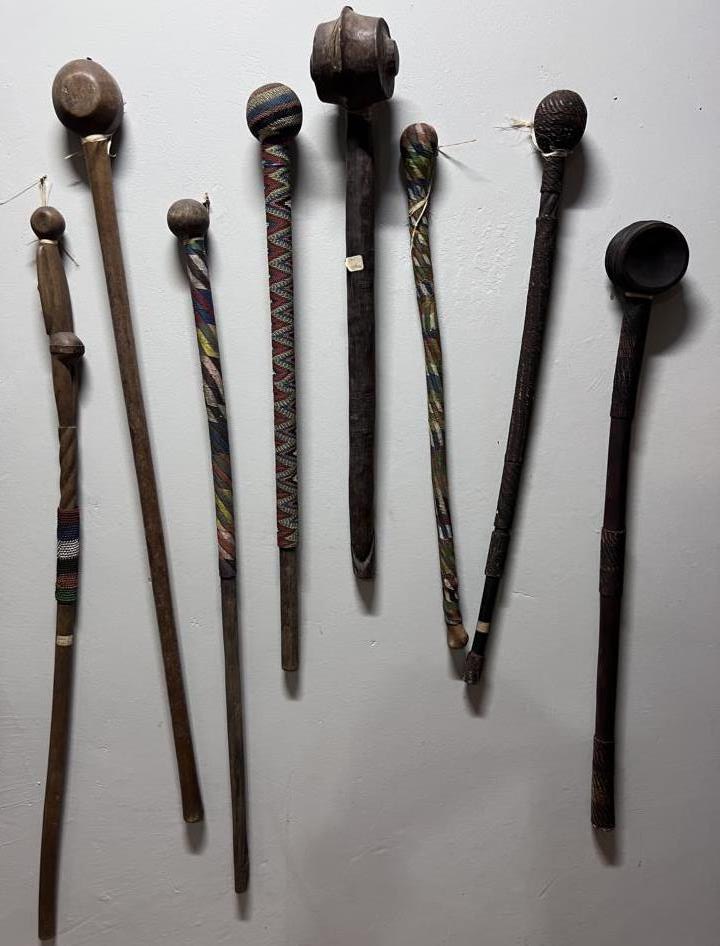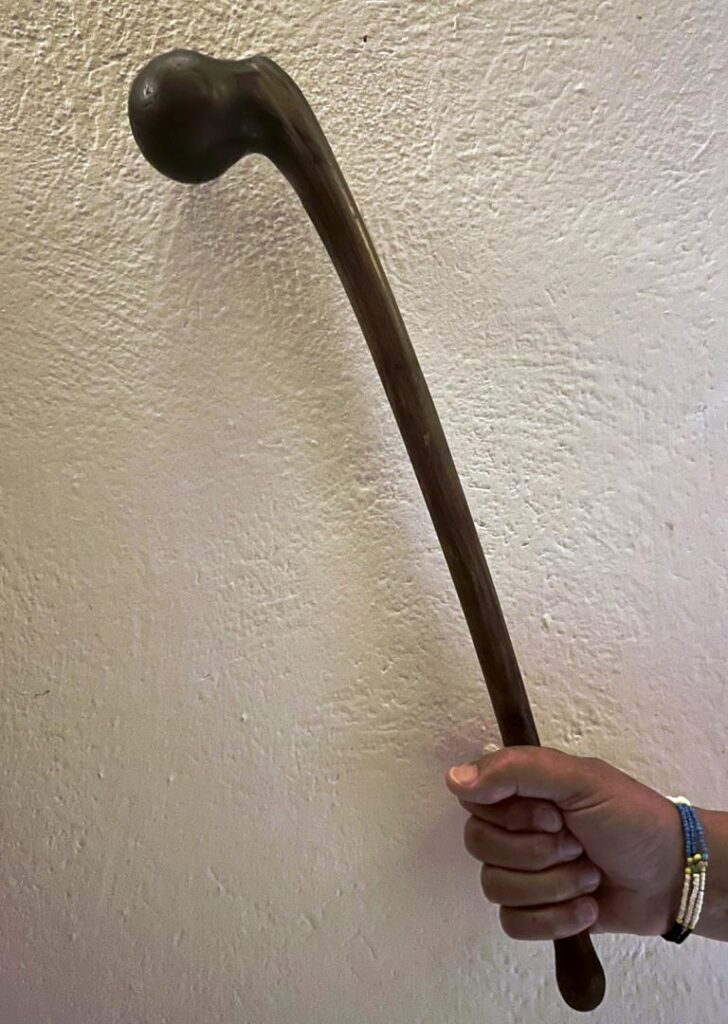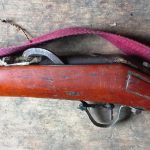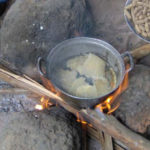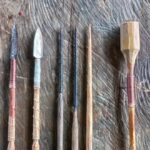Kerries combine throwing sticks and wooden clubs as everyday tools for hunting, defense, and digging in Southern Africa. Australian aboriginals used a refined form of throwing sticks, flattened over its whole length and called ‘Kylie’ by them. Eventually, boomerangs evolved from this design. They are very similar to a ‘Rabbitstick,’ as Americans call them.

The Kerrie did not figure significantly in ethnographical literature about African tribes, as it was just a piece of bent hardwood that was utilized and, after serving its purpose, replaced by a new one. It was, however, a typical tool of Khoi-san bushmen. Kerries were further refined by various tribes and are known as ‘Knobkerries’ by various Southern African tribes and ‘Rungus’ by Eastern African tribes, especially Masais in Kenya and Tanzania.

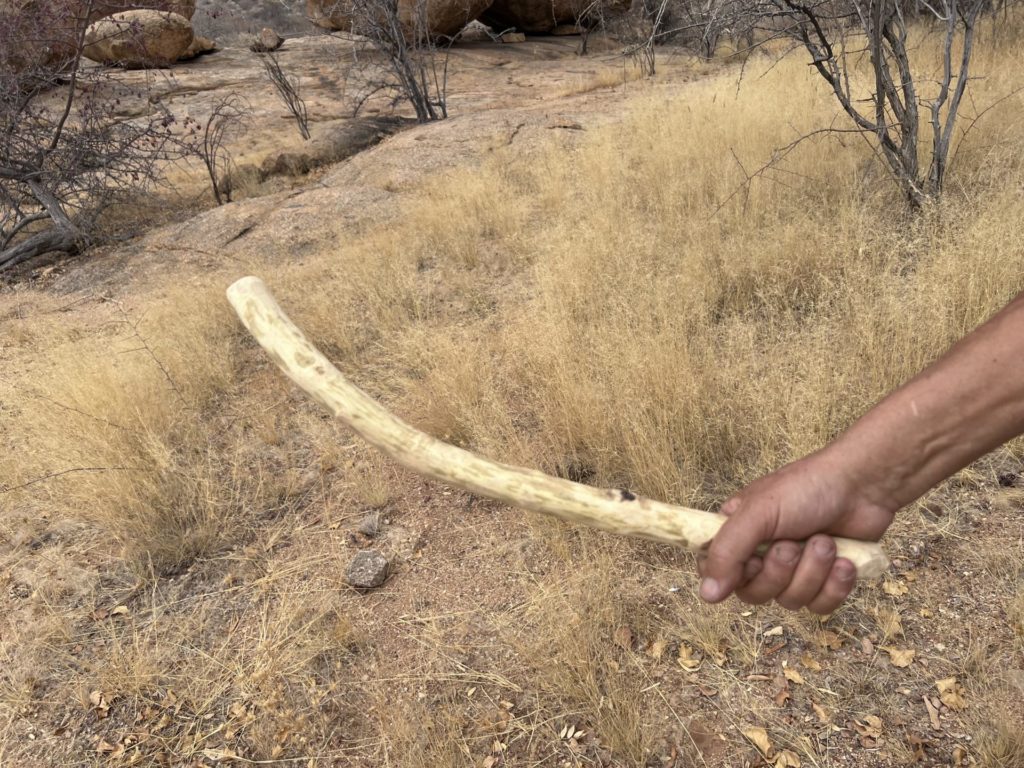
Brief description of Kerrie, Knobkerrie, and Rungu
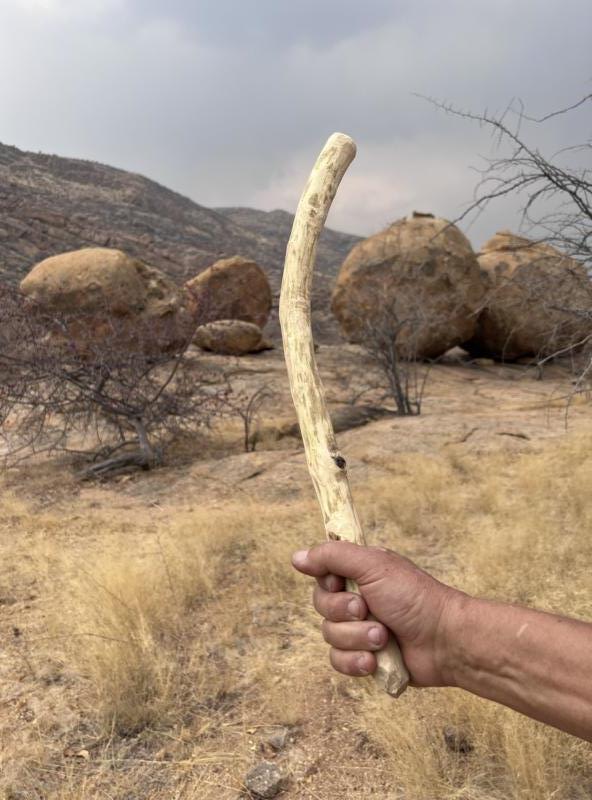
Kerries are about 45–50 cm / 17.5-20” long, with a 3–4 cm / about 1.5” in diameter, and slightly curved on one end. Ideally, they have a digging point at the end of the straight part opposite the bent section.
.
.
.
.
.
.
.
.
Knobkerries are straight sticks with a ‘knob.’ Such a knob is a symmetrical and ball-shaped extension on a straight stick. The length of the whole tool can be up to 1 m, and the diameter is smaller than that of an ordinary Kerrie. It is one of the three signature weapons of the Zulu nation. These are Assegai (short lance), Knobkerrie, and Zulu shield, which are made from Nguni cattle rawhide.
Knobkerries are not only carried by Zulus but also by Shonas, Swazi, Vendas, Tswanas, Xhosas, Sotho, and others. There is a wide variety of shapes and sizes, which are different for each tribe. And each tribe uses them slightly differently. For some tribes, the knobkerries serve mainly ceremonial purposes, for cattle herding, or as a walking stick. For others, their primary use is hunting and as war clubs. Depending on the uses, the type of wood is selected. Softwood species are chosen for cattle herders and ceremonial purposes; for hunting and war, hardwood species are necessary. Such hardwood originates preferably from ironwood, Tombotie or bush willows (Combretum spp.).
Rungus are similar to Knobkerries but got an eccentrically positioned knob. And they are often shorter in length compared to Knobkerries. Again, these throwing sticks have various shapes and sizes, as every Rungu is handmade. They are regarded as part of Tanzania’s national identity.
All three types of tools utilize the same principle when thrown in flight. Besides a straight part of the stick, they have an eccentric part. This causes the thrown club to swirl around its axis. This swirling action is most pronounced at Rungus and less so at Kerries. It is the least with Knobkerries, whose purpose is more of clubbing the opponent.
.
.
Utilization of throw sticks
As mentioned before, kerries are an everyday tool. They are readily available, can be made quickly, and serve various purposes. Therefore, they are ideal survival tools. At the former SAAF (South African Air Force) survival courses, kerries were the first tools made by the participants. Every participant had to carry two fist-sized stones and a throwing stick for defense and hunting throughout the courses.
Usage as a non-returning boomerang
The first purpose of a Kerrie is its use as a throwing stick for hunting ground birds and small mammals from a distance. Typical ground birds to hunt are Guineafowls, Francolins, Spurfowls, and Korhaans, and typical mammals are Scrub hares, Spring hares, Dik-Diks, and maybe Steenbuck. They can be carefully approached within throwing distance, which is, in practice, up to about 30 meters. The swirling flight of the throwstick can’t be easily judged by the animals, and there is a good chance of either breaking wings or hitting them subconsciously, especially if more people throw clubs at the same time and target.
The Kerrie has to be thrown parallel to the ground and given a particular spin for swirling. This action, as well as hitting a target, has to be practiced whenever possible. Setting up a competition for survival courses to see how often the participants hit practice targets is a good routine.
Usage as a clubbing tool
A Kerrie is also a clubbing tool, which can be used for offensive or defensive purposes. Examples of offensive utilization are Khoi-san Bushmen. In former times, they were kneeling behind jackal dens and waited for jackals to stick their heads out and club them. For defensive purposes, Kerries could be used with long, stout hardwood sticks, which serve as distance holders. If, for example, a hyena bites into the other end of the long stick – acting to keep the distance, the Kerrie can be used to break the upper nose bone of the hyena’s skull, which will discourage her further advances.
Usage as a digging tool
As an additional utilization, the straight end of the Kerrie can be sharpened on two sides (in sandy areas) or pointed (in more clayey soils) and used as a digging stick. Although digging sticks carried by female Khoi-sans are about double as long as Kerries, they can be used for a variety of digging and clearing tasks, e.g., digging for low-laying bulbs and roots or clearing ground of vegetation for temporary settling.
Lessons learned about throwing sticks.
- When stranded in the African bush, kerries are the most important first tool and weapon.
- They act as a throw stick for harvesting ground birds and small mammals
- Kerries can be used as an offensive and defensive club
- Additionally, they can be used as digging sticks
.

